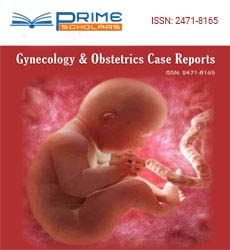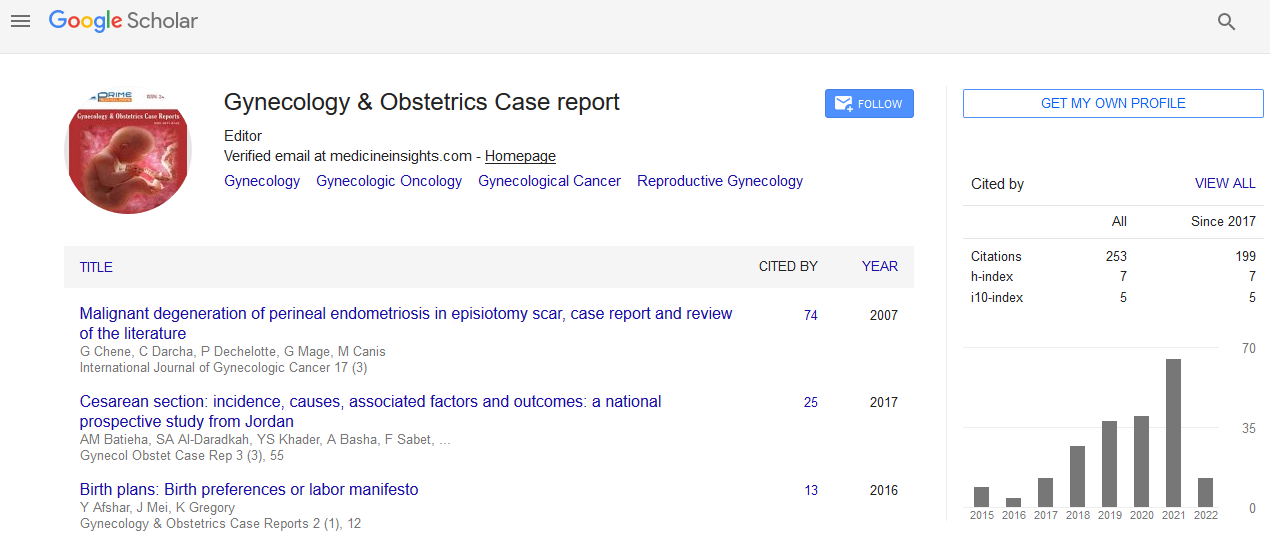Brief Report - (2025) Volume 11, Issue 2
Uterine Fibroids: Pathogenesis, Diagnosis, and Emerging Treatment Options
Madeline Clara*
1Department of Reproductive Health, Texas A&M University, College Station, TX 77843, USA
*Correspondence:
Madeline Clara, Department of Reproductive Health, Texas A&M University, College Station, TX 77843,
USA,
Email:
Received: 24-Feb-2025, Manuscript No. ipgocr-25-22710;
Editor assigned: 26-Feb-2025, Pre QC No. ipgocr-25-22710(PQ);
Reviewed: 10-Mar-2025, QC No. ipgocr-25-22710(Q);
Revised: 17-Mar-2025, Manuscript No. ipgocr-25-22710R);
Published:
24-Mar-2025, DOI: 10.36648/2471-8165.11.2.20
INTRODUCTION
Uterine fibroids, also known as leiomyomas or myomas, are the most common benign tumors of the female reproductive tract, predominantly affecting women during their reproductive years. These non-cancerous growths arise from the smooth muscle layer of the uterus (the myometrium) and can vary in size, number and location within the uterine wall. Although fibroids are usually benign, their clinical manifestations can range from asymptomatic cases to severe symptoms, significantly affecting a woman's quality of life [1]. The pathogenesis of uterine fibroids is multifactorial, involving complex interactions between genetic, hormonal and environmental factors. Estrogen and progesterone, two key ovarian steroid hormones, play a central role in fibroid development and growth. These hormones promote the proliferation of smooth muscle cells and the production of extracellular matrix, which together contribute to the enlargement of fibroids. Women with fibroids tend to have increased expression of estrogen and progesterone receptors in fibroid tissues compared to normal myometrial tissue. Additionally, fibroids often grow rapidly during periods of increased hormonal stimulation such as pregnancy and tend to regress after menopause, further supporting the hormonal dependency. Genetic studies have also identified specific chromosomal aberrations, such as rearrangements in chromosomes 6, 7, 12 and 14, which are commonly associated with fibroid tumors. Moreover, a familial predisposition has been observed, suggesting a heritable component. Environmental influences, including diet, stress and exposure to endocrine-disrupting chemicals, may also modulate fibroid development and progression [2].
The clinical presentation of uterine fibroids varies depending on their size, location and number. Many women with fibroids are asymptomatic and may be diagnosed incidentally during routine pelvic examinations or imaging. Symptomatic fibroids, however, can present with heavy or prolonged menstrual bleeding (menorrhagia), pelvic pain or pressure, urinary frequency or urgency, constipation and reproductive dysfunction including infertility and recurrent pregnancy loss. Fibroids are typically classified based on their location within the uterus: submucosal (beneath the endometrium), intramural (within the uterine wall) and subserosal (beneath the outer uterine surface). Submucosal fibroids are most commonly associated with abnormal uterine bleeding and infertility, while large subserosal fibroids may exert pressure on adjacent pelvic organs.
DESCRIPTION
The diagnosis of uterine fibroids relies primarily on clinical examination and imaging modalities. Transvaginal ultrasound is the first-line imaging technique due to its accessibility, low cost and high sensitivity in detecting fibroids. In cases where further evaluation is required, Magnetic Resonance Imaging (MRI) provides superior contrast resolution and can more accurately delineate the number, size and location of fibroids, particularly in women being considered for surgical or interventional treatment. Hysteroscopy and saline infusion sonohysterography can also be used for the assessment of submucosal fibroids and their impact on the endometrial cavity [3].
The management of uterine fibroids is guided by the severity of symptoms, size and location of the fibroids, the patient's age, reproductive plans and overall health. Traditional treatment options include pharmacological therapy, surgical intervention and minimally invasive procedures. Pharmacologic management focuses on symptom control and includes nonsteroidal anti-inflammatory drugs (NSAIDs), hormonal contraceptives and Gonadotropin-Releasing Hormone (GnRH) agonists or antagonists, which can induce a hypoestrogenic state and temporarily reduce fibroid size and bleeding. However, the long-term use of GnRH analogs is limited by adverse effects such as bone loss and menopausal symptoms [4].
Surgical options include myomectomy, which involves the removal of fibroids while preserving the uterus and hysterectomy, which is the definitive treatment involving removal of the uterus. Myomectomy is preferred for women who desire future fertility but carries the risk of fibroid recurrence. Minimally invasive procedures such as Uterine Artery Embolization (UAE) and Magnetic Resonance-Guided Focused Ultrasound Surgery (MRgFUS) have emerged as effective alternatives to traditional surgery. UAE works by cutting off the blood supply to fibroids, leading to their shrinkage, while MRgFUS uses high-intensity ultrasound waves to thermally ablate fibroid tissue.
Recent advancements in treatment have introduced novel therapies aimed at targeting the molecular and hormonal pathways involved in fibroid growth. Selective Progesterone Receptor Modulators (SPRMs), such as ulipristal acetate, have shown promise in reducing fibroid size and controlling bleeding, though concerns about liver toxicity have limited their use in some regions. Researchers are also exploring the use of aromatase inhibitors, mifepristone and other agents targeting fibroid-associated pathways. Additionally, regenerative medicine and gene therapy hold potential for future treatment modalities, although they remain in experimental stages. Uterine fibroids represent a significant health concern for women globally, with a complex pathophysiology and a wide spectrum of clinical implications. Early diagnosis and personalized treatment plans are essential to effectively manage symptoms and improve patient outcomes. With ongoing research into the molecular underpinnings of fibroid development, the future holds promise for more targeted and less invasive treatment options, offering hope to millions of women affected by this condition [5].
CONCLUSION
Uterine fibroids remain one of the most common benign tumors affecting women of reproductive age, with a significant impact on quality of life and reproductive health. Despite their prevalence, the exact pathogenesis is complex and not fully understood, involving genetic, hormonal and environmental factors. Advances in imaging techniques have improved diagnostic accuracy, allowing for earlier and more precise identification of fibroids. Treatment options have expanded beyond traditional surgical approaches, with newer, less invasive therapies offering promising outcomes. Emerging modalities such as uterine artery embolization, MRI-guided focused ultrasound and novel pharmacological agents provide alternatives tailored to patient-specific needs and reproductive goals. Continued research into the molecular mechanisms underlying fibroid development will be essential to identify targeted therapies, optimize management strategies and ultimately improve patient outcomes.
Acknowledgment
None.
Conflict of Interest
None.
REFERENCES
- Töz E, Özcan A, Apaydın N, Uyar Ä°, Kocakaya B, et al. (2015) Outcomes of vaginal hysterectomy and constricting colporrhaphy with concurrent levator myorrhaphy and high perineorrhaphy in women older than 75 years of age. Clin Interv Aging Jun 24(4):1009-1015.
Google Scholar Cross Ref Indexed at
- Stark M, Di Renzo GC, Benhidjeb T (2010) Natural Orifice Surgery (NOS)—Toward a single-port transdouglas approach for intra-abdominal procedures. Eur J Obstet Gynecol Reprod Biol Feb 148(2):114-117.
Google Scholar Cross Ref Indexed at
- Stark M, Gerli S, Di Renzo GC (2009) The importance of analyzing and standardizing surgical methods. J Minim Invasive Gynecol 16(2):122-125.
Google Scholar Cross Ref Indexed at
- Kontis V, Bennett JE, Mathers CD, Li G, Foreman K, et al. (2017) Future life expectancy in 35 industrialised countries: Projections with a Bayesian model ensemble. Lance 389(10076):1323-1335.
Google Scholar Cross Ref Indexed at
- Krieger N, Williams DR, Moss NE (1997) Measuring social class in US public health research: Concepts, methodologies and guidelines. Annu Rev Public Health 18(1):341-378.
Google Scholar Cross Ref Indexed at
Citation: Clara M. (2025) Uterine Fibroids: Pathogenesis, Diagnosis and Emerging Treatment Options. Gynecol Obstet Case Rep. Vol.11 No.2:20.
Copyright: © Clara M. This is an open-access article distributed under the terms of the Creative Commons Attribution License, which permits unrestricted use, distribution and reproduction in any medium, provided the original author and source are credited.

